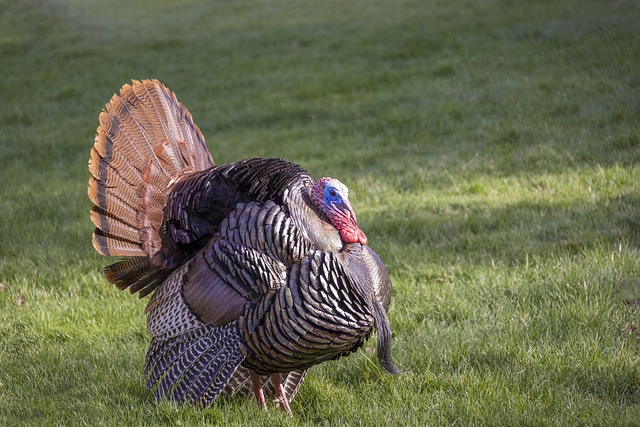Are Turkeys Hard to Hunt? Tips and Tricks for a Successful Hunt

Turkeys are a popular game bird among hunters in North America. However, the question of whether or not turkeys are hard to hunt is a topic of debate among hunters.
Some hunters claim that turkeys are one of the most challenging game birds to hunt, while others argue that they are relatively easy to hunt.
One factor that makes turkey hunting challenging is their keen senses. Turkeys have excellent eyesight and can spot movement from a long distance away.
They also have excellent hearing and can detect even the slightest sounds, making it difficult for hunters to approach them undetected.
Additionally, turkeys are known for their elusive nature, which makes them difficult to locate and track.
Despite these challenges, many hunters enjoy the thrill of turkey hunting and find it to be a rewarding experience. With the right skills and equipment, hunters can increase their chances of success and bring home a prized bird.
Whether or not turkeys are hard to hunt ultimately depends on the individual hunter’s experience and skill level.
Turkey Hunting Basics
Turkey hunting can be a challenging and rewarding experience for those who are willing to put in the time and effort to learn the basics. Here are a few key things to keep in mind when preparing for a turkey hunt:
Gear
Having the right gear is essential for a successful hunt. This includes a shotgun, ammunition, camouflaged clothing, a turkey call, and possibly a decoy.
It’s important to choose gear that is appropriate for the terrain and weather conditions you will be hunting in.
Scouting
Scouting is crucial for locating turkeys and determining their patterns. This involves studying maps, looking for signs of turkey activity, and listening for gobbling.
It’s important to scout well in advance of the hunt to give yourself time to learn the area and find the best spots.
Calling
Calling is a key aspect of turkey hunting. There are many different types of calls, including box calls, slate calls, and diaphragm calls. It’s important to practice your calling before the hunt to ensure that you can produce realistic and convincing turkey sounds.
Safety
Safety should always be a top priority when turkey hunting. This includes wearing blaze orange clothing to make yourself visible to other hunters, being aware of your surroundings, and never pointing your gun at anything you don’t intend to shoot.
By keeping these basic principles in mind, hunters can increase their chances of success and have a safe and enjoyable turkey hunting experience.
Understanding Turkey Behavior
Turkey Habitat
Turkeys are commonly found in wooded areas with open fields nearby. They prefer habitats that provide food, water, and shelter. They are often found in oak and hickory forests or in areas with dense underbrush. Turkeys also prefer areas with a mix of tall grass and open spaces.
Turkey Feeding Habits
Turkeys are omnivores and their diet consists of a variety of foods, including insects, seeds, and fruits. They often feed on the ground, using their sharp eyesight to locate food.
Turkeys are known to scratch the ground to uncover insects and other food sources. During the winter months, turkeys may rely on acorns and other nuts for food.
Turkeys are also known for their keen senses, including their excellent hearing and eyesight. They are able to detect movement from long distances and can quickly flee from perceived danger.
When hunting turkeys, it is important to remain still and quiet to avoid alerting them of your presence.
Understanding turkey behavior is key to successfully hunting them. By knowing their preferred habitat and feeding habits, hunters can increase their chances of success. It is important to approach turkeys with caution, as they are easily spooked and can quickly flee.
Why Turkeys are Hard to Hunt
Turkeys are elusive creatures that can be quite challenging to hunt. Here are some reasons why:
- Sharp Senses: Turkeys have excellent eyesight, hearing, and sense of smell. They can detect even the slightest movement or sound, making it difficult for hunters to approach them unnoticed.
- Fast Runners and Agile Flyers: Turkeys can run up to 25 miles per hour and fly at speeds of up to 55 miles per hour. This makes them difficult to catch, especially in open fields or when they take flight.
- Unpredictable Behavior: Turkeys can be unpredictable in their behavior, often changing their direction or pace without warning. They may also suddenly stop and become motionless, making it difficult for hunters to track them down.
- Seasonal Changes: Turkeys change their behavior and habits depending on the season. During mating season, for example, they become more vocal and active, making them easier to locate but harder to approach.
- Habitat Preferences: Turkeys prefer to live in wooded areas with plenty of cover, making it difficult for hunters to spot them. They also tend to move around frequently, making it hard to predict where they will be at any given time.
Overall, turkeys are challenging to hunt due to their sharp senses, fast movements, unpredictable behavior, seasonal changes, and habitat preferences. Experienced hunters must use their knowledge and skills to outsmart these elusive birds and successfully bring home a turkey.
Challenges in Turkey Hunting
Camouflage and Concealment
One of the biggest challenges in turkey hunting is getting close enough to the birds without being detected. Turkeys have incredible eyesight and can spot movement from a long distance away. This means that hunters need to be well camouflaged and concealed in order to avoid being seen.
Camouflage clothing is essential for turkey hunting. Hunters should wear clothing that matches the environment they are hunting in, such as green and brown for wooded areas or tan and gray for open fields.
It’s also important to wear a facemask, gloves, and a hat to prevent any exposed skin from giving away the hunter’s position.
In addition to camouflage clothing, hunters need to be concealed in a blind or natural cover. A blind is a structure that hunters can sit in to hide from the turkeys. Natural cover includes bushes, trees, and other vegetation that can be used to break up the hunter’s outline.
Calling Techniques
Another challenge in turkey hunting is using the right calling techniques. Turkeys are very vocal birds and can be called in using a variety of sounds. However, using the wrong call or using it at the wrong time can spook the birds and ruin the hunt.
There are several types of calls that hunters can use, including box calls, slate calls, and mouth calls. Each type of call produces a different sound and requires a different technique to use effectively.
Hunters should practice their calling techniques before heading out into the field to ensure they are using the right call at the right time.
Shot Placement
Shot placement is critical in turkey hunting. Turkeys have a small vital area, and a poorly placed shot can result in a wounded bird that is difficult to recover. Hunters need to aim for the head and neck area to ensure a quick, humane kill.
In addition to shot placement, hunters need to be aware of their surroundings before taking a shot. It’s important to know what is beyond the turkey in case the shot misses or passes through the bird. Hunters should also be aware of other hunters in the area and always practice safe firearm handling.
Overall, turkey hunting can be a challenging but rewarding experience. By using the right camouflage, calling techniques, and shot placement, hunters can increase their chances of a successful hunt.
Proper Hunting Equipment
Choosing the Right Firearm
When hunting turkeys, it is essential to have the right firearm. Shotguns are the most popular choice for turkey hunting because they offer a wide range of shot patterns.
A 12-gauge shotgun is the most common choice, but a 20-gauge can also be effective. It is important to choose a shotgun with a barrel length of at least 24 inches and a choke that is specifically designed for turkey hunting.
Another option is a rifle, but it is important to check local regulations before using one for turkey hunting. A .22 caliber rifle can be used for small game hunting, while a larger caliber rifle may be necessary for larger game.
Essential Hunting Gear
In addition to a firearm, there are several other pieces of essential hunting gear for turkey hunting. A turkey call is necessary to attract the birds.
There are several types of calls, including box calls, slate calls, and mouth calls. It is important to practice using the call before heading out into the field.
A camouflage outfit is also essential for turkey hunting. Turkeys have excellent eyesight and can spot hunters from a distance. A good camouflage outfit will help hunters blend into their surroundings.
Other essential gear includes a hunting vest, which can hold ammunition, calls, and other accessories, as well as a hunting knife for field dressing the turkey.
Overall, choosing the right firearm and having the essential gear is crucial for a successful turkey hunt.
Conclusion
In conclusion, turkeys can be both easy and hard to hunt depending on the circumstances. Factors such as the time of day, weather conditions, and the turkey’s behavior all play a role in determining the level of difficulty.
While some hunters may find turkeys to be elusive and challenging to hunt, others may find it to be a relatively easy task. It ultimately comes down to the hunter’s skill level and experience, as well as their ability to adapt to changing conditions in the field.
It’s important to note that hunting turkeys requires patience, persistence, and a deep understanding of the animal’s behavior.
Hunters must be willing to put in the time and effort to learn about their prey and develop the necessary skills to successfully harvest a turkey.
Overall, while turkeys can be a challenging animal to hunt, with the right approach and mindset, hunters can increase their chances of success and enjoy a rewarding hunting experience.
